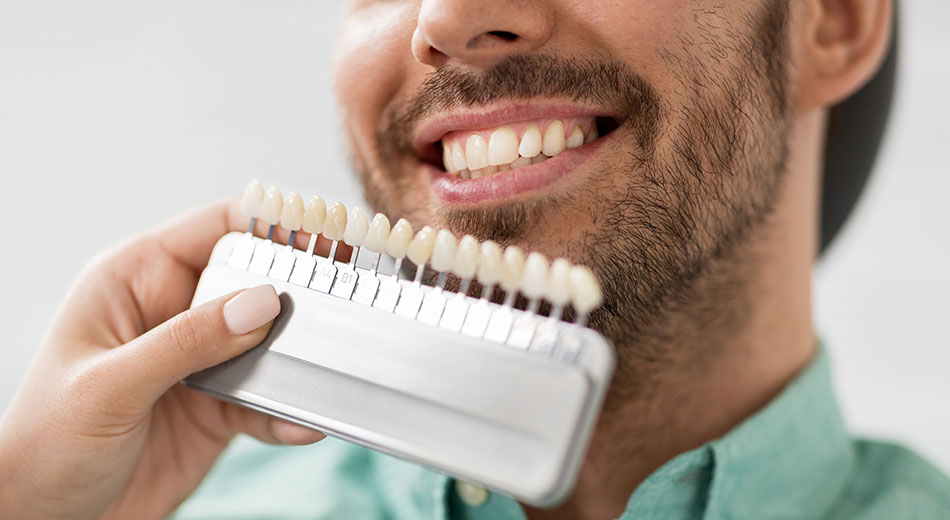Veneers are thin, shell-like layers that cover the teeth’ top or visible surface (the enamel). They consist of ceramic or porcelain materials, depending on which material you choose.
Veneers are cosmetic dental treatments that enhance the appearance of teeth. They can change not just the color of the teeth but also their shape, length, and size. They also closely match the color of the patient’s natural teeth.
What is the difference between porcelain and enamel veneers?
When you searched for “dental veneer near me,” you probably saw the words “resin” and “porcelain.” These two refer to two of the most common materials used to create dental veneers.
Composite veneers are made from the same materials used for bonding and filling teeth. The material has small particles of a hard material, making it soft and flexible. It allows the dentist to quickly sculpt and mold the material into any shape required.
These characteristics enable your dentist to fabricate custom composite veneers in their office. Your cosmetic dentist can place the veneer directly onto your teeth in one appointment.
Furthermore, most resin veneer treatments only require your tooth’s surface to be etched. It’s a technique that helps the shell bond and adhere better to teeth. With the composite resin veneer process, there is minimal tooth structure removal.
Porcelain veneers are similar to the resin kind in that they bond to the surface of your teeth. Porcelain veneers look much more like natural teeth than plastic ones because they reflect the light in the same manner. They’re more attractive than resin and often a better choice than resin.
According to studies, porcelain veneers are more long-lasting than composite resins. They’re durable, with most lasting for up to 20 years or even more. They can also resist stains better than resin.
However, these veneers require an indirect placement, taking longer than direct veneers. The entire porcelain veneer process usually takes at least two to three days. While you wait, you’ll put on temporary tooth covers to protect them.
What type of problems do veneers fix?
Veneers are usually enough for cracked, chipped, and broken teeth. They can also repair any rough spots caused by the wear of the enamel. If your entire tooth is worn down, you might want to consider getting dental crowns. Apart from physical damage, here are some other problems that veneers can help solve.
Stains and Discoloration
Professional teeth whitening can be an excellent way to remove stubborn tooth stains. If the discoloration is severe enough, you may want to consider going for dental veneers instead. These are covers, so they camouflage even the most unsightly teeth stains.

Misshapen Teeth
Some patients may have pointed teeth. Other times, these problematic teeth are misshapen or are smaller than the other teeth. This is known as microdontia, which affects around 1.5 to 2 percent of the population, and is often hereditary.
Veneers can quickly solve shape- or size-related tooth flaws. Your dentist can shape the temporary crowns to look just like the adjacent permanent teeth. This means that your teeth will be uniform both in shape, size, and alignment.
Diastemas
A diastema refers to a small gap between teeth. It often affects the upper or lower front tooth. They’re not a significant health concern, but they can cause unwanted shifting or movement of your teeth. Patients with spaces between their teeth run an increased risk of developing gum disease.
If the teeth move too much when chewing, they can be misaligned, leading to a bad bite. According to studies, some of these problems can raise a person’s risk for tooth decay. Veneers can fill in small gaps between teeth, as a dentist can reshape and resize teeth using the covers of veneer.
Are veneers right for you?
Your dentist will evaluate the state of your teeth and gums and discuss all available treatments. If you decide to go ahead, your dentist will examine your mouth and take X-rays so he can determine whether teeth need to have any preparation done before veneers are placed. The next step is to prepare your teeth for your specific procedure. This will ensure they look and feel right after the process is completed.
During your consultation, our team will discuss your preferences for the shapes, lengths, widths, and colors of the veneers and the changes in the appearance of your teeth that you’d like to achieve. You help ensure that your treatment meets your expectations. Your dentist must understand your objectives during your veneer consultation.
For more information about veneers or a free consultation, contact us today.



